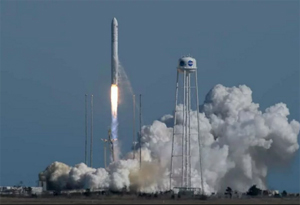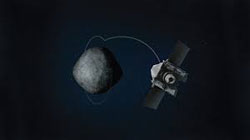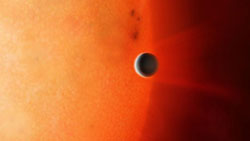June 2019 Science and Technology
Sakshi Education

- Sri Lanka launches first satellite `Ravana-1`
Sri Lanka's first satellite 'Ravana-1', designed and developed by two local engineers, was successfully launched into orbit from the International Space Station (ISS) along with two other BIRDS 3 satellites from Japan and Nepal.
Raavana 1 is the cube satellite. Raavana-1 is expected to fulfil five missions including the capturing of pictures of Sri Lanka and surrounding regions.
- NASA’s Curiosity rover confirmed the presence of Methane in Mars
NASA has confirmed that the Curiosity rover, the NASA’s Mars Science Laboratory mission, recently detected the largest amount of methane ever measured during the mission. Curiosity’s methane reading came to 21 parts per billion units by volume. It is thrice the amount it sniffed out during a surge in 2013.
During a follow-up test later, though, scientists found that the methane levels around the rover already dropped sharply. Curiosity detected normal methane levels, that is 1 part per billion by volume, following the sudden elevation. It suggested that the abnormally high values came from transient methane plumes.
As Curiosity is not equipped with instruments to determine whether the source of methane is biological or geological, the scientists are yet to figure out a pattern for Martian’s transient plumes.
The scientists plan to gather more information through Curiosity and from other missions to gain a deeper understanding of the plumes. The scientist will be able to understand whether the presence of methane on the red planet truly is a sign of life only if they finds where the plumes are coming from.
- Three astronauts landed after spending more than six months aboard the International Space Station (ISS)
Oleg Kononenko with the Russian space agency Roscosmos, Anne McClain of NASA and Canadian Space Agency astronaut David Saint-Jacques landed aboard Russia's Soyuz MS-11 spacecraft on June 24. The landed after spending more than six months aboard the International Space Station (ISS).
Astronauts Anne McClain of the United States and David Saint-Jacques of Canada had completed their maiden flights. The expedition commander Oleg Kononenko of Russia has ended his fourth space mission. All three spent 204 days in space.
Soyuz MS-11 was the 57th Russian Soyuz spacecraft to fly to the International Space Station. It traveled a total of 86.4 million miles (139 million kilometers) over the course of 3,264 orbits of Earth.
The crew members participated in spacewalks, performed a lot of experiments and performed a good amount of repair work.
- Indigenously developed nuclear-capable missile Prithvi-II test fired successfully
India successfully test-fired indigenously developed nuclear-capable missile Prithvi-II as partof a user trial by the Army from a test range off the Odisha coast.
The trial of the surface-to-surface missile, which has a strike range of 350 km, was carried out from a mobile launcher from Launch Complex-III of the Integrated Test Range, ITR at Chandipur.
The missile is capable of carrying 500 to 1000 kg of warheads and is powered by liquid propulsion twin engines.
Prithvi-II was also successfully test-fired on 21st February, 2018 from the ITR at Chandipur.
- NASA witnessed biggest methane gas emission
NASA has confirmed that the Curiosity rover recently detected the largest amount of methane ever measured during the mission.
The levels were enough to pause the rover's activities as scientists sought more answers.
Curiosity's methane reading came to 21 parts per billion units by volume, which is thrice the amount it sniffed out during a surge in 2013.
- Google Maps launched Stay Safer feature
Google Maps introduced India-first 'Stay Safer' feature for its users.
The feature will alert and notify users traveling in taxis, auto-rickshaws when their vehicle goes off-route and also share the live status of their trips with friends/family.
Indian users will be able to use the new feature on their Android phones with the latest version of Google Maps.
- NASA announced a new mission to explore Saturn's largest moon
NASA announced a new mission to explore this fascinating world with a helicopter drone.
The mission, called Dragonfly is the latest in NASA’s New frontier program. NASA has earlier launched explorations of Pluto, Jupiter, the asteroid Bennu, and now, Titan.
- NASAs OSIRIS REx spacecraft creates new record
 NASA’s OSIRIS-REx spacecraft entered its second orbital phase around asteroid Bennu, called Orbital B.
NASA’s OSIRIS-REx spacecraft entered its second orbital phase around asteroid Bennu, called Orbital B.
It broke its own world record for the closest orbit of a planetary body.
The OSIRIS-REx spacecraft was sent to study the asteroid Bennu and return a sample from its surface to Earth.
The spacecraft is on a seven-year journey.
- Scientists places worlds highest weather stations atop Mount Everest
Scientists from National Geographic Society and Tribhuvan University installed have installed two highest weather stations in the world in an expedition to Mount Everest that wrapped up in June 2019.
The two weather monitoring stations are located at an altitude of 8,430 meters (27,657 feet) and 7,945 meters (26,066 feet). Also, three other stations have been set up across the Mount Everest.
The setting up of the weather station aim to collect weather data. The data gathered from the stations will help scientists to understand how rising global temperatures impacts the rapidly melting glaciers.
The nearly two month expedition involved a team of more than 30 scientists from all over the world, including 17 Nepali researchers.
The team also collected the world highest ice core sample at 8,020 meters , which will help the scientists study the deep record of precipitation on the mountain and composition of the atmosphere during pre-industrial times.
The project also reached another milestone of placing the world's highest helicopter-based lidar scan and the most detailed photogrammetric imaging, also with lidar scans, of the Everest Base Camp area and the entire Khumbu Glacier.
- ISRO opens its laboratories for Indian school students
Indian Space Research Organisation (ISRO) is an agency which has the legacy of India’s ancient knowledge and modern technology.
She opened its laboratories for Indian school students to undergo two-week training from this year.
first batch 108 students drawn from all states.
Union Territories completed their exposure in its laboratories in Bengaluru, Sriharikota, Thiruvananthapuram.
The training module devised as part of its new Young Scientists Programme.
Yuva Vigyanik Karyakram, YUVIKA.
ISRO’s YUVIKA is modeled around the Indian government’s vision ‘Jai Vigyan, Jai Anusandhan’.
The initiative is primarily aimed at imparting basic knowledge on Space Technology, Space Science and Space Applications to children to kindle their interest in the emerging areas of space activities.
The two-week-long program would include invited talks, experience sharing by eminent scientists, facility and lab visits, exclusive sessions for discussions with experts, practical and feedback sessions.
- Lander and rover meant for Chandrayaan-2 reaches ISRO’s launch pad at Sriharikota
The lander and rover meant for India’s second lunar mission Chandrayaan-2 reached the ISRO’s launch pad at Sriharikota.
The rover called Pragyan is installed within the lander known as Vikram. They were flagged off from ISRO laboratory in Bengaluru on 17 June, 2019.
Earlier, the orbiter that will house the lander and the rover reached the launch pad at the Satish Dhawan Space Center, Sriharikota on 15 June, 2019.
Chandrayaan-2 will be launched aboard India’s most powerful booster GSLV-Mark-3 tentatively early in the morning on July 15th with the aim of making the lander to soft-land on the South Pole of the moon by September 6th.
India would be the fourth country to have its probe soft-land on the moon.
"As the orbiter, lander and the rover of Chandrayaan-2 are all in the launch pad in Sriharikota, the scientists of the national space agency are now assembling them together. Later, Chandrayaan-2 will be integrated with the rocket GSLV Mark-Three for its launch as per schedule.
The rover, the lander and the orbiter, all have payloads meant for collecting data on the nature of the moon surface. Once the orbiter reaches the lunar orbit of 100-kilometre distance from the moon, the lander will emerge from it and make a slow descend on the lunar south pole. Once it soft-lands, the rover will leave the lander and move around the moon’s surface, collect samples and analyse them. The lunar south pole remains an unexplored area so far and Chandrayaan-2 is expected to unravel some of the mysteries of the earth’s only natural satellite.
- World to get half its power from solar energy
Nearly half the world’s electricity will come from renewable energy by 2050 as costs of wind, solar and battery storage continue to plummet.
That titanic shift over the next three decades will come as electricity demand increases 62% and investors pump $13.3 trillion into new projects.
Coal will be the biggest loser in the power sector, with its share of global generation at 12% in 2050.
- NASA funded programme to produce videos
A programme funded by NASA in the U.S. has produced a series of videos about popular archaeological sites and institutions in India.
The videos come with lesson plans in Hindi, to aid in teaching the language internationally using themes of science and technology.
The NASA-funded programme STARTALK made a USD 90,000 grant to Ved Chaudhary, director of the project.
- Facebook launches world’s most detailed 'population density maps' for Bangladesh, other countries of Asia Pacific
Facebook has launched the world’s most detailed and advanced “population density maps” using artificial intelligence (AI) for Bangladesh and other countries of Asia Pacific.
The map shows an estimate of the number of people living within 30-meter grid tiles. It includes demographic data such as the number of children under five as well as the number of women of reproductive age.
The new AI-powered and high-resolution maps will help address large scale social, health and infrastructure issues in the area. Facebook has used publicly and commercially available data-sets like satellite imagery and census data to create the population density map which does not contain any personally identifiable information.
It has collaborated with Columbia University in the US to build these maps.
The map will be helpful in disaster management efforts at the in time of natural calamities and humanitarian crisis.
- Indian Navy to build 6 submarines
Indian Navy issued an ‘Expression of Interest’ for shortlisting potential strategic partners.
The construction of six P-75 (I) submarines costing nearly Rs.45,000 crore.
This is the second project being undertaken under the latest Strategic Partnership (SP) Model.
The procurement of 111 naval utility helicopters (NUH) are obtained recently.
They provide a major boost to the indigenous design and construction capability of submarines in India.
The latest submarine design and technologies as part of the project.
‘Make in India’ issued the Expression of Interest(s) for shortlisting of potential Indian Strategic Partners (SPs) for construction of six conventional submarines for P-75(I) project of the Indian Navy on June 20.
The case was approved by the Defence Acquisition Council on January 31.
The Expression of Interest (EoI) for shortlisting of Indian strategic partners been uploaded on the Defence Ministry and Navy websites.
The EoI for shortlisting of Original Equipment Manufacturers (OEMs) will be issued in two weeks.
- Remdesivir may help protect against Nipah
 An experimental antiviral drug, remdesivir, designed to treat Ebola virus disease can effectively help fight off Nipah virus.
An experimental antiviral drug, remdesivir, designed to treat Ebola virus disease can effectively help fight off Nipah virus.
Remdesivir completely protected four African green monkeys from a lethal dose of Nipah virus.
Remdesivir, is being developed by Gilead Sciences, Inc. in collaboration with scientists from the Centers for Disease Control and Prevention (CDC).
- Team Indus to build moon lander for NASA
Team Indus is part of a consortium that has bagged a contract from NASA to design and build a lander for its next lunar mission in 2020.
NASA has awarded the consortium a $97 million contract to fly four payloads to Mare Imbrium, a lava plain in one of the Moon’s craters, by September 2020.
- NASA to test green fuel for spacecraft
NASA is planning on testing a new fuel for spacecraft.
Dubbed the Green Propellant Infusion Mission (GPIM) it uses a non-toxic, rose coloured solution that can be a breakthrough in space exploration.
The GIPM is a spacecraft which will use the aforementioned fuel to power the mission.
- Hypersonic missile successfully test fired
India conducted a successful first test flight of the Hypersonic Technology Demonstrator Vehicle (HSTDV) from a base off the Odisha coast.
The only other countries that possess this technology are the US, Russia, and China.
The HSTDV is an unmanned scramjet demonstration vehicle that can cruise up to a speed of mach 6 and rise up to an altitude of 32. km in 20 seconds.
- India to build space station in 7 years
India will build its own space station in low earth orbit to conduct microgravity experiments in space in 5 -7 years.
The proposed Indian space station would be much smaller than the existing International Space Station (ISS).
The prospects of setting up such a space station at an altitude of 400 kilometres from Earth would hinge on successfully carrying the 'Gaganyaan' human space mission.
- Astronomers discovered the Forbidden Planet, NGTS- 4b in the Neptunian Desert
 An international collaboration of astronomers with the University of Warwick, I-JK, have discovered an exoplanet, Next-Generation Transit Survey(NGTS)- 4b, the Forbidden Planet, in the Neptunian Desert.
An international collaboration of astronomers with the University of Warwick, I-JK, have discovered an exoplanet, Next-Generation Transit Survey(NGTS)- 4b, the Forbidden Planet, in the Neptunian Desert.
It is smaller than Neptune but 3 times the size of the Earth.
The Research was led by Dr. Richard West including Professor Peter Wheatley, Dr. Daniel Bayliss and Dr. James McCormac from the Astronomy and Astrophysics Group at the University of Warwick.
The Forbidden Planet with a mass of 20 Earth masses, radius 20% smaller than Neptune and temperature of 1000 degree Celsius, orbits around the star in only 1.3 days and its atmosphere as gases.
NGTS, situated at the European Southern Observatory Paranal Observatory in the Atacama Desert, Chile.
- James Webb Space Telescope successfully passed final thermal vacuum test
NASA's $8.8-billion James Webb Space Telescope, the world's largest and most expensive one, has successfully passed final thermal vacuum test, making its parts cleared for use in space.
The 6.5-meter diameter telescope has 18 gold-coated mirrors and a tennis court-sized sun-shield to gather light and protect its instruments. The telescope set to launch in 2021. It took 20 years to build.
- Two-day Elephanta Festival begins in Mumbai
The MTDC organises the festival every year to promote tourism and the culture of Mumbai.
The festival is held on Gharapuri island, which was christened Elephanta by the Portuguese after they found a statue of an elephant on the island.
- India will make America’s private moon lander
The first US lunar lander in the 21st century will be designed in India.
NASA says it will spend more than $250 million hiring private companies to transport scientific missions to the moon.
Three companies—Astrobotic, Intuitive Machines, and OrbitBeyond—have been awarded contracts for missions into 2021.
- NASA’s first SpaceX astronauts ready for space
The first U.S. astronauts chosen to fly aboard a SpaceX capsule built for NASA.
Space shuttle veterans Bob Behnken, 48, and Doug Hurley, 52 are slated for blastoff later this year from Cape Canaveral,Florida. In the debut manned flight of the Crew Dragon capsule to the International Space Station.
California-based SpaceX, the privately owned venture owned by billionaire entrepreneur Elon Musk.
- China launches rocket from ship at sea
China successfully launched a rocket from a ship at sea for the first time.
The Long March 11 rocket blasted off from a platform on a large semi-submersible barge in the Yellow Sea.
The small rocket designed to be deployed quickly and from mobile launch sites such as a ship,carried seven satellites including one that measures sea-surface winds to forecast typhoons.
- Google Maps launches features for real-time updates on public transports in India
Google tech Behemoth invented three new features- bus travel times from live traffic in 10 of the largest cities in India
The live train status for Indian Railways trains, and mixed-mode commute suggestions that now combine auto-rickshaw and public transport.
The travel plan of Indian users are predicted by transit time while traveling on buses.
Google map enable users to know how long a bus trip will take when factoring in live traffic conditions
This feature launched in 10 cities namely Delhi, Bangalore, Mumbai, Hyderabad, Pune, Lucknow, Chennai, Mysore, Coimbatore, and Surat.
The partnership app is Where is My Train app acquired by Google in December 2018.
It helped for Google’s ‘Next Billion Users’ initiative.
The feature is live in two cities in Delhi and Bengaluru.
India is the top three countries for Google Maps transit usage.
The search engine over 300 million users in the country.
Google Map has more than 10,000 routes it can predict the transit time accurately.
It will be available on Android and iPhones.
Apple hiring spree to expand its products in India.
- World Oceans Day is celebrated on 8th June
World Oceans Day is celebrated on 8th June every year. The day was declared in 2008. June 8 was marked as it marks the day when it was first proposed in 1992 by Canada's International Centre for Ocean Development (ICOD) and the Ocean Institute of Canada (OIC) at the Earth Summit, UN Conference on Environment and Development (UNCED) in Rio de Janeiro, Brazil
The Conference supported the implementation of Sustainable Development Goal (SDG) 14 of the 2030 Agenda for Sustainable Development: Conserve and sustainably use the oceans, seas and marine resources for sustainable development.
The theme for the year 2019 is Gender and Oceans. The theme is to build greater ocean and gender literacy and to discover possible ways to promote gender equality in ocean-related activities such as marine scientific research, fisheries, labour at sea, migration by sea and human trafficking, as well as policy-making and management.
The importance of gender equality is being recognized increasingly for the effective conservation and sustainable use of oceans, seas, and marine resources. Yet very little data and researches are available on these issues. Serious action towards gender equality and the empowerment of women and girls is still needed in all ocean-related sectors to achieve Sustainable Development Goal .
Published date : 14 Jun 2019 03:02PM



















